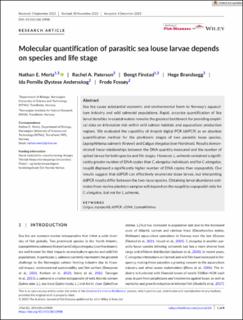| dc.contributor.author | Mertz, Nathan Edward | |
| dc.contributor.author | Paterson, Rachel | |
| dc.contributor.author | Finstad, Bengt | |
| dc.contributor.author | Brandsegg, Hege | |
| dc.contributor.author | Andersskog, Ida Pernille Øystese | |
| dc.contributor.author | Fossøy, Frode | |
| dc.date.accessioned | 2024-03-07T09:13:36Z | |
| dc.date.available | 2024-03-07T09:13:36Z | |
| dc.date.created | 2024-01-11T10:09:40Z | |
| dc.date.issued | 2023 | |
| dc.identifier.citation | Journal of Fish Diseases. 2023, . | en_US |
| dc.identifier.issn | 0140-7775 | |
| dc.identifier.uri | https://hdl.handle.net/11250/3121387 | |
| dc.description.abstract | Sea lice cause substantial economic and environmental harm to Norway's aquacul-ture industry and wild salmonid populations. Rapid, accurate quantification of lice larval densities in coastal waters remains the greatest bottleneck for providing empiri-cal data on infestation risk within wild salmon habitats and aquaculture production regions. We evaluated the capability of droplet digital PCR (ddPCR) as an absolute quantification method for the planktonic stages of two parasitic louse species, Lepeophtheirus salmonis (Krøyer) and Caligus elongatus (von Nordman). Results demon-strated linear relationships between the DNA quantity measured and the number of spiked larvae for both species and life stages. However, L. salmonis contained a signifi-cantly greater number of DNA copies than C. elongatus individuals and for C. elongatus, nauplii displayed a significantly higher number of DNA copies than copepodids. Our results suggest that ddPCR can effectively enumerate louse larvae, but interpreting ddPCR results differ between the two louse species. Obtaining larval abundance esti-mates from marine plankton samples will depend on the nauplii to copepodid ratio for C. elongatus, but not for L. salmonis. Caligus, copepodid, ddPCR, eDNA, Lepeophtheirus | en_US |
| dc.language.iso | eng | en_US |
| dc.publisher | Wiley | en_US |
| dc.rights | Navngivelse 4.0 Internasjonal | * |
| dc.rights.uri | http://creativecommons.org/licenses/by/4.0/deed.no | * |
| dc.title | Molecular quantification of parasitic sea louse larvae depends on species and life stage | en_US |
| dc.title.alternative | Molecular quantification of parasitic sea louse larvae depends on species and life stage | en_US |
| dc.type | Peer reviewed | en_US |
| dc.type | Journal article | en_US |
| dc.description.version | publishedVersion | en_US |
| dc.subject.nsi | VDP::Klinisk veterinærmedisinske fag: 950 | en_US |
| dc.subject.nsi | VDP::Clinical veterinary sciences: 950 | en_US |
| dc.source.pagenumber | 8 | en_US |
| dc.source.journal | Journal of Fish Diseases | en_US |
| dc.identifier.doi | 10.1111/jfd.13908 | |
| dc.identifier.cristin | 2224364 | |
| dc.relation.project | Andre: Fiskeri - og havbruksnæringens forskningsfond | en_US |
| dc.relation.project | Egen institusjon: Norwegian institute for nature research (NINA) | en_US |
| dc.relation.project | Andre: NTNU | en_US |
| dc.relation.project | Andre: Det Norske Veritas | en_US |
| cristin.ispublished | true | |
| cristin.fulltext | original | |
| cristin.qualitycode | 1 | |

